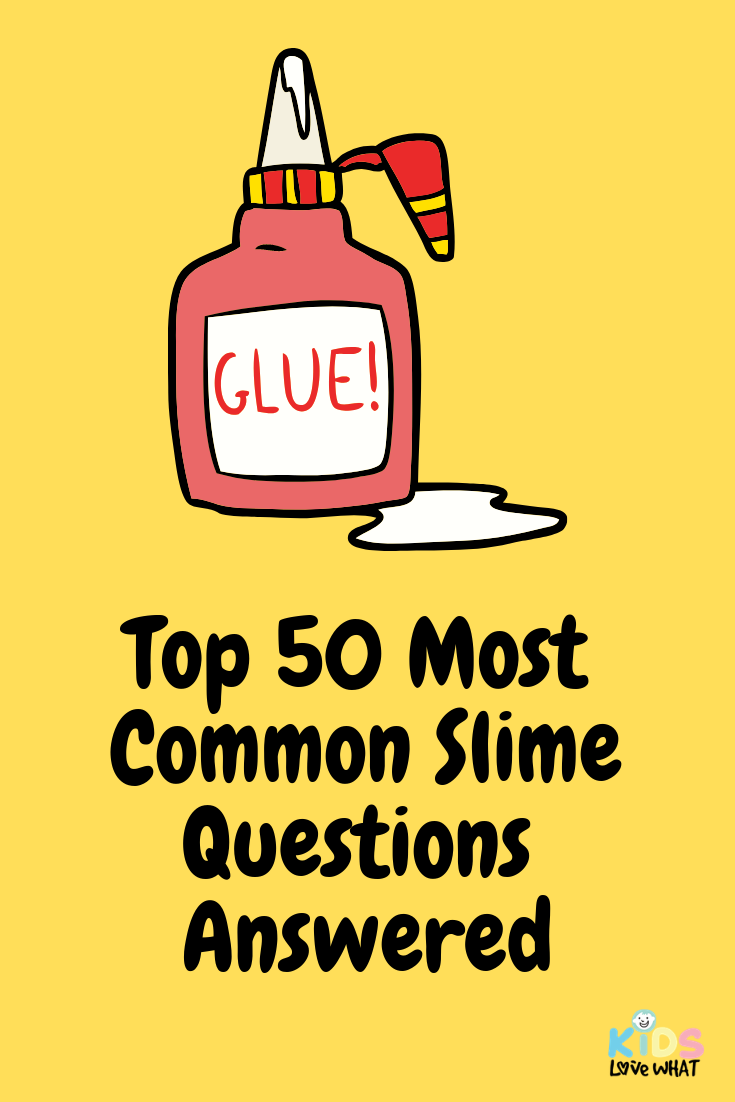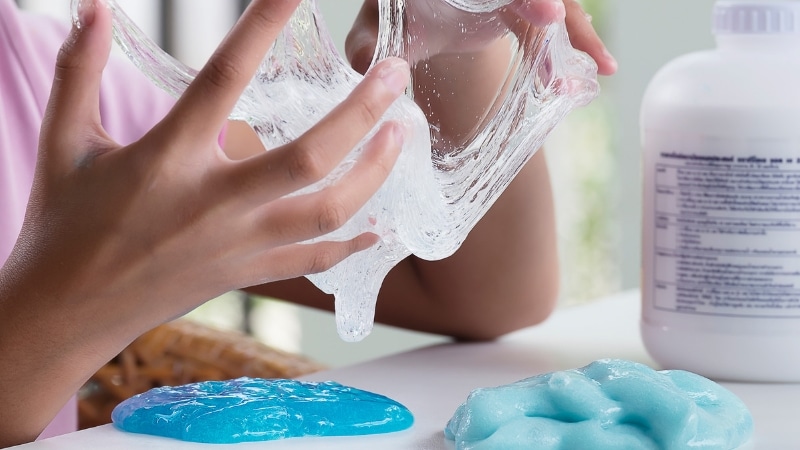Slime has hit the world by storm. Chances are you have either made it with your kids or have watched them watch other kids making it on YouTube. There are countless variations of slime. From edible slime to heat reactive slime, each recipe is unique and requires different ingredients.

With the limitless possibilities, the process can become overwhelming. This is why we are bringing you the top 50 most common questions about slime and answering them for you! This list is designed to not only answer your questions about the slime-making process, but also touch on various recipes, the learning elements and problems you may encounter along the way. So, sit back, relax and continue reading to bring a little more clarity to the craze that is slime. And be sure to head over to our top ranked science kits for kids list here once you’re done!
1. What is the science behind slime?
Slime, when resting in your hand flows like a liquid. When you squeeze it, it feels like a solid. So, what is slime really? Slime is a liquid but with a unique characteristic that allows it to change consistency dependent on stress that is applied to it. This form of liquid is known as a Non-Newtonian liquid. To make such a liquid, you need something called an activator. The activator is what brings your slime together into a lump of squishy goodness. The activator causes the molecules in the glue to bond closer together. You can experiment using different activators to achieve various consistencies. For a more scientific explanation about slime making, visit the American Chemical Society’s website.
2. How do you make fluffy slime?
Fluffy slime is a light and airy slime that resembles a cloud. This type of slime is a unique sensory experience that changes over time. The key ingredient here is foam shaving cream. Shaving cream has a lot of air in it which aerates the slime. As the shaving cream settles, the slime will change consistency before your eyes. This is great for making hypotheses (educated guesses) on what will happen and observations as changes occur.
You will need:
- White glue (make sure this is the PVA variation like Elmer’s)
- Baking soda (the cheaper, the better on this!)
- Food coloring (optional)
- Saline solution (activator)
- Shaving cream (the foam kind)
The steps to create this fluffy concoction are:
- Measure 3-4 big cups of shaving cream and add it to your bowl. (different amounts here will give you different textures. I recommend trying with more and less shaving cream and observe the differences!)
- If you are adding color, do so now. Food coloring is a popular choice to add color to slime. (I love the McCormick Neon assortment you can find at your local grocery store. There are also other ways to add color to your slime like pigment too)
- Add ½ cup of glue to the shaving cream and mix well
- Add ½ tsp of baking soda
- Add 1 tablespoon of saline solution to the mixture and start stirring (make sure your saline solution has boric acid in it – this is VERY important! Your slime will not work if it does not have boric acid in it (this should be visible on the ingredients list on the bottle)
- Once all ingredients are incorporated and the slime is starting to come together, you can start kneading the mixture with your hands (Pro tip: put a little saline solution on your hands before picking up your fluffy slime — this mitigates any initial sticky mess)
This recipe is one of my favorites and we can all thank Little Bins For Little Hands.
3. How do you make crunchy slime?
This slime recipe with a twist provides a satisfying crunch when squeezed! This form of slime can also be known as floam or bubble wrap slime due to the popping noises it makes when squeezed and rolled. This recipe is excellent for molding and shaping because the beads give it a bit more structure than your average slime.
The recipe is straightforward! You will need:
- 1 cup of glue (again, make sure it’s PVA. I prefer to use white Elmer’s for this mixture, but clear glue works just as well!)
- ½ cup water
- ¼-½ cup liquid starch (or saline solution if you’re using clear glue)
- Small foam balls (there are TON’s of colors to choose from on Amazon – check them all out here)
As far as the small foam balls go, we love to use the colored variations as it brightens the overall appearance of the slime and having different colors makes making this with it more fun!
Instructions:
- First, you will pour the glue into a large bowl
- You will then add water and mix well
- Now it’s time to add in the liquid starch (activator)
- Add in your foam balls slowly and mix them in as you go
- Use your hands to finish mixing. This Kneading process makes the slime less sticky. So if it’s sticking to your hands, keep going!
This recipe was based on the information I found over at Childhood 101. Make sure to give them a visit!
Note: Be sure that when adding your activator, you do so slowly. The activator is what brings the mixture together. Adding too much or too fast can throw the consistency of the mixture off.
4. How do you make clear slime?
This particular formulation of slime is trickier than the others. It tends to not be as stretchy and gooey as white slime, but there are some tricks that can be done. It requires various water temperatures throughout the steps to ensure proper mixing, while maintaining that glass like appearance. It is essential that you follow the steps and measurements closely to achieve that crystal clear like slime!
What you’ll need:
- 8 oz. of clear glue (Colorations NGL washable clear glue or Elmer’s washable clear glue will work)
- 8 oz. of warm water and 4 oz. of cold water
- 2 tsp. baking soda
- 2 tbsp. saline solution
You can cut this recipe in half if you would like – it works just as good.
To make the perfect clear slime:
- In a bowl: Combine all of the glue, cold water and saline together and mix slow enough to avoid creating bubbles (this could affect the end result of clarity)
- In a different bowl (or cup): Mix the warm water and baking soda together. The temperature of the water will help the baking soda dissolve more quickly
- Put the warm water mixture into the glue mixture and stir again nice and slow, trying to avoid any air bubbles
- Let this mixture sit for about 10 minutes
- Now the mixture should be ready! Go ahead and pick it up and knead it until the stickiness subsides.
If the slime is still too sticky, feel free to add a little more saline solution. Just make sure to add a little at a time, followed by kneading. Adding too much may completely take the stretch away!
5. How do you make slime less sticky?
This is dependent on the kind of slime that was made. Fluffy slime is generally the least sticky of all slimes. If you are just starting out and worried about your slime being sticky, try out the fluffy slime recipe here. Most of the time, if the recipe has been followed closely enough, kneading the slime in your hands repeatedly should significantly reduce or eliminate any stickiness. If that doesn’t work, try a small bit of oil (baby oil works great and smells great!) or more saline solution. Rub it on your hands then continue kneading away. Certain slime recipes need to settle after getting too warm in your hands. Letting the slime sit on a counter or even sit back in a storage container can let it cool down and be ready to play with again. If you’re working with a brand-new batch of slime, being slightly sticky is very common, so don’t worry!
6. What ingredients are needed to make basic slime?
Each recipe of traditional slime is similar in that they each have a base (such as glue) and an activator (such as saline). For the most basic of slime, all you would need is:
- PVA glue (Elmer’s preferred)
- Saline solution (activator)
Instructions: Simply pour the desired amount of glue into a bowl. Then, start to slowly add a little of the saline solution and stir. You will notice the slime starting to get clumpy. Continue adding a little bit more saline to the mixture until all of the slime has come together and starts detaching from the sides of the bowl. You can always add in more saline solution if the slime is too sticky, but make sure to not add too much! Kneading the slime will lessen the stickiness a lot!
7. How do you make butter slime?
Butter slime gets its name because it mimics the consistency of real butter. The trick here is to use the right modeling clay. Daiso modeling clay makes the butter clay much softer than other brands, but other brands still work too (like Model Magic).
You will need:
- 6 oz. of PVA glue
- 1 ½ tsp. of baking soda
- 1 tbsp. of warm water
- 1 ½ tsp. of saline solution
- Small piece of modeling clay (I recommend Daiso brand, but again, Model Magic works fine)
Instructions:
- Pour glue, baking soda and warm water into a bowl and stir
- Slowly add the saline solution and mix. Add more solution if the mixture is still too sticky to mold
- Once the stickiness has subsided, pick up your slime and place on a flat, clean surface and knead the slime a few times
- Begin to fold small bits of the piece of clay into the slime
- Knead until the bits of clay is thoroughly mixed into the slime
Here is a slightly different variation that inspired this recipe.
The finished product should be butter soft and spreadable! Try using a knife to spread the slime on the counter or slice through it. So fun!
You can also add some shaving cream to your butter slime and turn it into fluffy butter slime. The kids absolutely love this kind of slime and is probably their favorite out of all.
8. How do you make slime without borax?
There are many substitutes for borax in slime recipes. In borax recipes, borax is the activator. This means that any other activator can be used to replace it in existing recipes. As you can see in the recipes throughout this article, many do not include borax. The most common substitute for borax is saline contact solution that contains boric acid. This allows the concoction to activate without utilizing harsh detergents such as borax that have been said to cause skin irritation. For a full list of alternative activators, click here.
9. Is slime edible?
This is entirely contingent on the recipe used. There are dozens upon dozens of recipes out there made specifically for edible slime. It is recommended always to check each ingredient to ensure its safety for consumption. Here are some of my favorite types of edible slime:
- Gummy bear slime
- Skittles slime
- Pudding slime
- Swedish fish slime
- Cotton candy slime
- Gum slime
- Laffy taffy slime
- Candy corn slime
- Nerds slime
- Caramel slime
- Starburst slime
- Jolly rancher slime
- Jell-O slime
10. Can you make slime without glue?
Yes, there are plenty of alternatives to using glue in a slime recipe. Dish soap is the most common household item used as a replacement. You can also use things such as yogurt, liquid body wash, shampoo, bananas, toothpaste, and the list can continue. As you can see all these items have a very similar viscosity to one another. That being said, this area is open for experimentation. I challenge you to find some safe household items with a similar viscosity to glue and use it in common glue slime recipes and see what happens. Slime is a cool science experiment, don’t be afraid to test away!
Experiment: Try adding some cornstarch to dish soap and stir. Watch as slime will start to magically form!
11. How do you make slime with baking soda?
Baking soda is a common slime ingredient. It aids in the formation of the slime and in larger quantities combined with a liquid detergent can be used as an activator. Here is a common slime recipe using baking soda:
You will need:
- ½ cup washable PVA glue
- ½ cup warm water
- 1 tsp. of baking soda
- 4 tbsp. saline solution (amount is dependent on consistency goal)
Instructions:
- Empty your glue into a bowl
- Put baking soda in the container with warm water and mix gently
- Combine baking soda water mix to the glue and mix until totally combined
- Start adding contact solution and stir it in as you go until your goal consistency is achieved
12. How do you make slime with liquid detergent?
I love a good smelling slime recipe. Liquid detergent slime will make your entire house smell like you have been doing laundry all day! I prefer using Tide brand detergent.
All you need is:
- ½ cup of white PVA glue
- Your favorite liquid laundry detergent
Instructions:
- Put your glue in a bowl
- Slowly add the liquid laundry detergent while stirring
- Continue stirring until the slime forms
- At this point, it’s okay to take out the slime and begin kneading it
This type of slime I have found is the easiest to get out of clothes! Pop the item in the washer on warm and the detergent goes back to its original state, plus the glue breaks down without having to scrub!
13. Where can you buy those little foam balls for crunchy/floam slime?
These foam balls are available at pretty much any craft store (Michael’s, AC Moore, etc). However, my favorite place to find these little guys is on Amazon and eBay. The selection on these sites is huge! Variations in color and sizes are easy to locate and bulk pricing is always great too. Here is a great little starter kit I found on Amazon with 15 different color variations for just $8.99 (price subject to change) and its Prime eligible!
14. Where can you buy bulk glue?
I am going to sound like a broken record here, but Amazon is a great one stop shop for all things slime. Bulk glue is no different! Here is a two-gallon Elmer’s school glue lot for $20.00 (price subject to change) with FREE Prime shipping! You can also find glue by the gallon at Costco, Sam’s Club, Michael’s and Hobby Lobby.
15. What are the different kinds of slime activators?
Slime activators are arguably the most critical element to creating slime. The activator is what pulls all of the other ingredients together to aid in solidifying the mixtures we all know and love. With that being said, there is a laundry list of activators that can be used.
Slime activators include:
- Borax powder
- Saline contact solution (must have sodium borate or boric acid)
- Liquid starch
- Eye drops or eyewash (again must have boric acid)
- Liquid laundry detergent
- Salt
- Sugar
- Liquid fabric softener
16. How do you get slime out of clothes?
Depending on the garment (and your freezer space) you can put it in your freezer for 10-15 minutes. This will give the slime enough time to harden on the garment, making it easy to scrape away by hand or with a dish brush. If there is a residual stain, white vinegar is a great pretreatment. Liberally pour white vinegar on the stained area and let stand for 5 minutes. Rinse the item in warm water and throw it in the wash as usual. It should be good as new!
What you don’t want to do is not take any action. Letting your clothes sit with slime on it will only make the process of de-sliming extremely difficult.
17. What kind of glue is needed to make slime?
There are two key elements that are important to look for when shopping for the perfect slime glue. The glue must be washable. For your sanity. Washable glue is designed to wash away when it gets on things it’s not supposed to be on. On the more complex side of things, the glue must have an ingredient called polyvinyl acetate or PVA. This is a liquid polymer that allows the glue to bind with the activator to create that perfect slime consistency.
18. How do you make scented slime?
There are plenty of scented additives that you can put in your slime. Lots of recipes already have scented elements such as liquid detergent, dish soap, shaving cream, etc. If your recipe does not have any scented elements, you can try experimenting with essential oils. I have found that adding some lavender essential oil to the slime mix lets off an amazing aroma. The kids love it too! You can buy all sorts of different essential oils from Amazon – everything from fruity to herbaceous scents.
Did you know that you can twist some lemon or orange peels and the oils will be released onto your slime for a wonderful citrus scent? Give it a try!
19. How do I make slime softer and more stretchy?
If you are looking for a soft slime recipe, I recommend trying the butter slime recipe or fluffy slime recipe. If you are working with an older batch of slime that has hardened over time, you can do a few things to try and bring it back to life. If your slime has lost its elasticity, you can place it on a hard, clean surface, form it into a bowl with an indentation in the middle and fill it with some lotion. Pick the slime up and begin kneading the lotion in. This should restore the stretch and also aid in reviving the softness as well. Another method that I found works is by adding older slime to warm/hot water and mixing. This will work back in some moisture and soften the slime up.
20. How long does slime usually last?
Typically, slime doesn’t spoil. Slime can stiffen and even grow brittle over time. Storing in an airtight container can slow this from happening and boost the longevity of your slime. Slime is relatively inexpensive to make, so if it gets dirty or collects debris, it may just be time to toss it and make new. Another longevity-boosting tip from Craft City Life Blog is once your glue bottle is relatively empty fill it up with warm water and shake to make a lotion-like substance with the remaining glue in the bottle. Treat your slime every few days with a few drops of this substance to keep it supple longer. It is important to note that any edible slime should be refrigerated and thrown out after a few days.
Don’t have any containers laying around? Ziploc bags work wonders and are a cheap way to keep your slime safe and air free.
21. What is the best way to store slime?
It is always a good idea to store slime in an airtight container. We generally use Ziploc bags for two reasons. One is that they are easy to release all the excess air out of. The other reason is the take up a small amount of space and can be stored flat. There is plenty of other containers you can use such as these 4 oz. plastic containers with lids that can be reused.
22. What are the best ways to color my slime?
There are a few ways you can color slime. Just like when adding scent, color can be added in the same step that you add the glue. The most common form of color is food coloring. We love the McCormick neon assortment. However, food coloring is very messy and can stain your hands and clothes! If you want to use something less messy, you can add pigments. Here is a great pack of 12 pigment colors for $8.99 (price subject to change). Some recipes provide their own coloring through their ingredients such as the edible Jell-O.
23. How can I make my slime jiggly?
If you want to make your slime a bit jigglier (is that even a word?!), try to slowly mix in some warm water. This will help break apart the bonds that were formed when the activator was added and create that perfect jiggle. The amount of water you add is contingent on what recipe was used. The best advice that I can give is to add small amounts at a time and mix thoroughly before adding more. Continue this process until the desired results are achieved.
24. Can I use lotion or oil in my slime?
Yes! Some butter slime recipes call for lotion in the initial recipe. Lotion and baby oil are great additives to help soften and revive aged slime as well!
25. Why is my slime so hard?
Depending on the age of your slime there can be a few reasons for this. If you have just made the slime, you probably added too much activator. Try adding a small bit of warm water to your slime to soften it up. If this is aged slime that has grown hard over time, this is from the gradual evaporation of the moisture in the slime. Try adding a small amount of lotion, oil, or even more glue into the slime and it should revive it to its former glory.
26. Why is my clear slime not entirely clear/transparent?
I highly recommend that you follow the clear slime recipe carefully. It should come out pretty close to perfect every time. If your slime doesn’t turn out clear, it could be because you stirred the ingredients too vigorously and created too many bubbles (which cause a cloudy effect). Letting your clear slime sit in an air-tight container for a few days (untouched) will help bring all of the air bubbles to the surface and create a transparent look once again. If your slime was once clear and has grown cloudy over time, it is more than likely caused by dirt and debris on the play surface or even your hands. Making sure the surface is clean and your hands are freshly washed is an excellent way to ensure you maintain clarity in your clear slime.
27. How do I fix slime that has too much liquid or is too runny?
Your fix may be as simple as adding a bit more activator to your mix. You can also try thickening your mixture by using cornstarch, shaving cream (for your fluffy formula) or baking soda. If your slime has components such as shampoo or detergent, try putting your slime in the freezer for a few minutes. It will give it the proper time and environment to set up fully.
28. Can you freeze slime?
Of course! This is a great addition to slime sensory play. Put your slime in the freezer for about 2 hours. The slime will freeze hard and be brittle. This is an excellent opportunity to make some observations of how the slime has changed form. Feel free to play with it before it starts to unthaw! It may start to become a little slimy as it starts to get warmer, so make sure you have some paper towels handy in case there is a mess. Your slime should return back to its original state after a few hours sitting out.
29. How do you make sand slime?
If you live too far from a beach, this slime is an excellent escape to beachy sensory! Sand slime adds a gritty twist to your average slime recipe. The type of sand you use in this isn’t critical, but the different variations of sand will leave you with different textures in the end. I prefer craft sand that you can pick up at local craft stores for a few dollars. They generally have colors to choose from, which adds a nice color pop to your slime. A big bag of sandbox sand will do just fine as well. This sand is not as heavily sifted as craft sand, so it is probably going to be a bit on the chunkier side in comparison.
Ingredients:
- 1 cup of white glue (PVA kind)
- 1 large cup of foam shaving cream
- ½ cup sand (if this is not enough for your liking, you can add more! I like to use Sands Alive in this recipe)
- ½ cup liquid starch
Directions:
- In a large bowl combine your glue
- Add shaving cream to the bowl and mix well
- Now mix in the sand. If you feel that you need more sand, you can add more without jeopardizing the integrity of the recipe
- It’s time to add your activator. In this case, we will be using liquid starch (½ cup should effectively activate the slime into the ideal sandy consistency)
- Knead the slime until any remaining stickiness subsides
This recipe was found at Eating Richly.
30. How do you make stress balls using slime?
A stress ball made with slime can be made with any variation of slime. You will need a balloon and a funnel (I like to cut the neck off of an empty water bottle to create a makeshift funnel). Stretch the balloon around the neck of the water bottle or if using a funnel, stick the bottom part of the funnel into the balloon. Next, you will slowly funnel your slime into the balloon. Once all slime has made its way into the balloon, you can tie it off and begin squeezing out your frustrations!
Fun tip: I’ve found that adding Orbeez or other squishy items to the mix makes the stress ball feel even better!
31. How do you make color changing slime?
Color changing slime is created by heat reactive pigment. This pigment can be purchased here. You can use solar or thermal pigment. Solar is affected by UV rays, while thermal pigment is affected by temperature. Both of these come in a variety of color combinations. This pigment is added to your slime mixture just like any other color. I recommend adding color at the same time that glue is added in.
32. Can you make slime with only two ingredients?
Since slime only requires a polymer base and an activator, a two ingredient slime is possible. In a two ingredient recipe, you will start with your base in a bowl and mix your activator in slowly. Once the slime gains some anatomy, you can pull it from the bowl and knead it as usual. The easiest two ingredient slime to make is equal parts of glue and liquid starch. You can also make 2 ingredient slime out of equal parts of toothpaste and salt. Or glue and saline solution. Try them all out and see which one you like the best!
33. What happens if you add too much activator?
Depending on the activator used, your slime can become too hard. This is especially prevalent with saline solution activators. I have found that liquid starch as an activator is the most foolproof though. You can combat the overuse of an activator by adding things such as baby oil or lotion to soften the hardened mixture. Another way to combat too much activator is adding some warm water.
34. Is making slime safe for kids?
As with any science experiment, parental supervision is always recommended. If a child has sensitive skin, it may be wise to have the child wear gloves while making and playing with slime. Recipes that use harsh chemicals such as borax have been known to cause burns in some cases. There are also hazards if non-edible slime accidentally gets consumed. It is essential to do further research as far as adverse reactions are concerned to various forms of slime and age appropriateness of specific slime recipes.
35. What kind of clay should you use in slime?
Clay is a critical ingredient in some recipes like butter slime. Although all modeling clay can be used, you will get different results from various kinds of clay. For the butter recipe, I recommended Daiso brand modeling clay due to its flexibility and softness. This particular clay mixes into slime with ease, while others require a bit more effort to mix fully. Model Magic is another good alternative if you can’t find the Daiso brand.
36. Can I use shaving gel in my slime or only shaving cream?
Shaving gel can be a substitute for foam shaving cream in the fluffy slime recipe. It should be known however, that the result will not be as “airy” as traditional foam shaving cream is. The gel will show less shrinkage than a foam mixture will as well. So if you want a more sustainable quantity of fluffy slime, gel may be a great alternative.
37. Can ingredients for slime be premixed in advanced?
Yes! Excluding some edible formulations that might spoil, you can premix slime ingredients leaving only the activator out until it’s time to make the slime. This is a great way to prepare ahead of time to make slime with a large group. If you are preparing for a group slime extravaganza or having a party with kids, I recommend pre-measuring all non-activator ingredients and combining them in a sealable container. To save even more time, you can measure out the activator and store that in a separate container too. This way when your group is ready for slime time, all that you need to do is distribute one container of each to the participants and they can mix the two together without having to measure and go through all the steps.
38. Why did my slime shrink?
This is a common occurrence in fluffy slime in particular. Most fluffy slime is made with foam shaving cream which holds air molecules throughout. As gravity takes its toll on slime, the air molecules slowly escape causing visible shrinkage in fluffy slime. This is an unavoidable element to fluffy slime with the foam shaving cream. An alternative is to utilize gel shaving cream which lacks the fluffy air elements. Your slime will not be initially as fluffy, but it should remain a uniform consistency throughout its life.
39. Why does my slime smell bad?
The short answer here is bacteria! Our hands and surfaces are common ground for bacteria. This becomes transferred to the slime in play. Storing warm (from touch) slime in a bag at room temperature creates an ideal environment for bacteria to flourish, which causes the foul odor. You can avoid smelly slime by ensuring that your hands and play surfaces are clean and sanitized. This limits bacteria transfer to the slime. Storing slime in the fridge can also minimize bacteria growth as well.
40. How do I remove slime from hair?
If you have a small portion of slime stuck in the hair, grab an ice cube and hold it to the area. This should harden the slime and make it much easier to remove by hand. If you’re like my kid and a lot of slime got into their hair, dish soap/shampoo/conditioner will be your best friend. Head to the bath (or shower) and run the water as warm as comfortable. Work the dish soap, shampoo or conditioner into their hair. A large amount may be required depending on just how much slime is involved. Lather the soap through the affected area and you will notice the slime breaking down and washing out on its own. This may take a few lather and rinses, but always seems to get the job done.
41. How do you make magnetic Slime?
This is possibly one of the more advanced recipes in this article. This is scientifically engaging and tons of fun. Since the magnets are small and consumption is absolutely not allowed with this recipe, parental supervision is required!
Ingredients:
- ¼ cup liquid starch
- ¼ cup white school glue (PVA)
- 2 tbsp. iron oxide powder
- Neodymium magnet (this kind of magnet is crucial as a regular household magnet will not be strong enough for the tiny particles)
Directions:
- Pour liquid starch into a bowl
- Add iron oxide powder and mix well
- Add glue and mix until slime forms
- Continue by kneading by hand. (Warning — this will turn your hands super black, so either wear some gloves or wash your hands immediately following the initial kneading process)
- Use a paper towel and pat the slime to pull out any excess liquid. Once the excess liquid is gone, the slime shouldn’t turn your hands black any longer and it will be ready to go!
- Run the Neodymium magnet around the slime and see what happens!
42. How do you make glow in the dark slime?
Much like color pigments, you can purchase glow in the dark pigment! Solar Color Dust is a one-stop shop for all the cool pigments that you can use in your slime! Like other color additions, this pigment needs to be added in with the glue (or base) phase of the slime making process and mixed into the base well. Then continue on with the original recipe as normal. Once the slime is complete, the slime may need to be “charged” in order to glow. Setting it on a sunny windowsill for 30 minutes should do the trick! Turn off the lights and enjoy!
43. Can you draw on slime?
Yes! Plain white slime seems to work the best for this! Flatten your slime with your hand or a rolling pin to create your artistic canvas! Grab some sharpies and get to drawing (don’t worry, it shouldn’t come off on hands or ruin your beloved sharpies!). We love to draw faces, then stretch the slime to distort our creations. This makes for tons of laughs and hours of fun!
44. How do you avoid stained hands when making slime?
The easiest way to avoid stained hands is to wear rubber gloves. Some slime formulations are just going to stain your hands due to the nature of the ingredients. Another way to lessen the work it takes to get any staining off your hands is to wash them right after the initial hand kneading phase of making slime. This attacks the staining before it has time to settle into your skin. You can also minimize the amount of coloring agent being used. If color is transferring to your hands, there is a possibility you used a bit too much.
45. How do you make chalkboard slime?
Similar in nature to regular drawing slime. The difference is that this slime requires ⅓ of a small bottle of Black chalkboard paint. Mix in well with the glue (or base) and continue on with the recipe. Once the slime is complete, grab some chalk markers (the neon-colored chalk markers are our personal favorites!). Draw away with markers and stretch and distort your art. The best part about these markers and this slime is if you ball the slime up and knead it thoroughly, your art will fade away and you can start all over again!
46. How do you make bouncy balls out of slime?
Though these bouncy balls are not the super balls you can get from the quarter machine, they are lots of fun to make and do bounce a good foot or so in the air! I urge you to test your finished project by bouncing it on various surfaces to see which surface gives the highest bounce.
Ingredients:
- 1 tsp. Borax
- 4 oz. warm water
- 1 tbsp. cornstarch
- 1 tbsp. Elmer’s glue (clear or white, but must be PVA)
- Two small mixing cups or bowls
- Optional – 2 -3 drops food coloring
Directions:
- Set one mixing cup aside for a Borax solution mixture and set the other cup aside for your bouncy ball mixture
- Starting with the Borax solution cup, pour warm water in with the Borax powder. Stir this mixture until it’s dissolved
- Using the bouncy ball mixture cup, pour in the glue. If you are using the optional food coloring, add 2-3 drops of your color/s of choice to the glue
- Put both the borax solution cup and bouncy ball mixture cup side by side. Transfer ½ tsp. of Borax solution combined with 1 tbsp. of cornstarch into the bouncy ball mixture cup filled with colored glue
- Now watch the ingredients interact for a brief 10-15 seconds and then begin stirring them together until they are fully mixed
- Eventually, the mixture will harden to the point where you can no longer stir
- Remove this mixture from the cup now and start rolling and kneading it with your hands while slowly forming it into a ball
Science Bob was the inspiration for this recipe — check their variation here!
What begins as a gooey, sticky mess will turn into a smooth and round bouncy ball.
47. How do you get slime out of my carpet?
Slime is messy. Obviously. Any mom or dad who has children knows that making slime is fun, but cleaning up? Not so much. Unfortunately, cleaning up must be done, but what do you do when the dreaded slimy mess lands straight on your carpet?
Fear not, you can get it out! I must stress that prevention is vital. Storing your slime in containers will cut down on most accidents. Cleaning up as you go along helps, too. However, there is always some slime that somehow gets left behind. Whether it’s on your hands, clothes feet…. it’s SOMEWHERE.
In most cases of slime spillage, vinegar will be your go-to cleaner. For carpet, in particular, you will want a ratio of ⅔ cup of vinegar to ⅓ cup of warm water. Combine the mixture into a bucket. Using a soft bristle brush, start pouring the vinegar solution onto the slime-stained carpet and gently begin scrubbing to lift and loosen the slime from the carpet fibers. Next, using a clean and dry towel, start blotting the carpet to help absorb the excessive solution. If you still see some slime, continue this process repeatedly until slime is lifted entirely out of the carpet. Once the carpet feels dry to the touch, vacuum up any leftover residue.
48. Will slime grow mold?
The short answer is, yes. Slime can absolutely grow mold. However, depending on the ingredients used in your homemade slime and the type and location of where your slime is stored also contributes to how quickly and how much mold can grow.
For instance, if your homemade slime uses a combination of edible ingredients (flour, baking soda, vinegar, food coloring, cornstarch, gelatin, etc.) it has a higher chance that mold will contaminate and begin growing on your slime. Ingredients such as soap, borax, contact lens solution, paint, glue, etc. will help to counteract the growth of mold on your homemade slime.
Keep in mind the container matters! Options include baggies, Tupperware and saran wrap to name a few, but the more airtight your storage container, the less likely mold will grow! Another tip to prevent mold is storing your slime in the refrigerator! Last, but not least, always make sure to wash your hands before playing with slime and have a clean surface as well.
49. How do you make metallic slime?
Use your favorite non-edible recipe for this cool color addition. Watercolor paints can be found in numerous metallic colors (our favorites are cobalt blue and midnight metallic!) These can be hard to locate in stores, so when in doubt search Amazon! Here is the set I grabbed. During the glue adding phase of your slime mixing, break off a few pieces of the watercolor tablets and break it up between your fingers, sprinkling it into the glue. Make sure to mix thoroughly. Continue with the recipe as stated.
50. How do you make fizzy slime?
Fizzy slime is always a crowd favorite. If your kids love making erupting volcanoes, then they will absolutely love making this slime. The fizzing is a quick initial reaction, so make sure they pay close attention! This recipe makes a Strawberry Scented Fizzy Slime! Yum! We find this most resembles lava and the kids go wild, as the fizz flows freely!
Ingredients:
- Flour
- Baking soda
- Corn starch
- Vinegar
- Strawberry gelatin powder
Instructions:
- Start with 2 cups of flour
- Add ¼ cup of cornstarch and ¼ cup of baking powder to flour
- Pour in the strawberry scented gelatin powder
- Be sure to stir the mixture
- While continuing to stir the dry mixture slowly, begin pouring in water a little bit at a time until proper consistency is reached. About one cup is needed
- Now to make it Fizzy!
- Scoop out individual batches to each kid participating
- Pour ¼ cup of vinegar out into a bowl
- Using a tbsp. measuring spoon, scoop out one spoonful of vinegar in a bowl and add to each child’s individual batch of slime
- Watch the slime FIZZ!!
The combination of the baking soda and vinegar causes the slime to become fizzy!
No glue needed!
This recipe was inspired by Look We’re Learning.






